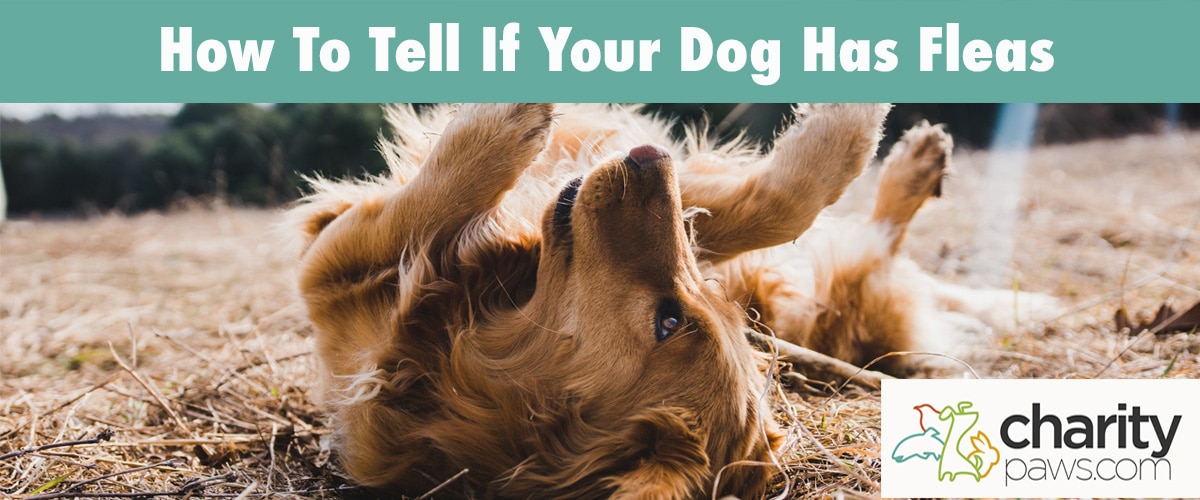Fleas… even just the mention of this little creepy crawly is enough to make us feel itchy! Ctenocephalides felis (known as the cat flea) is one of the most common parasites that veterinarians see in practice.
This nuisance parasite is not fussy and will infect cats, dogs, and rabbits as well as biting humans too.
Their bites are itchy and uncomfortable but can also transmit disease, so it’s important to deal with them quickly.
Let’s take a look at the clues that could indicate your dog has a flea problem.

What Are The Signs Your Dog Has Fleas?
If your dog has fleas, then you might see some of the following symptoms:
- Excessive scratching and nibbling
- Red, inflamed skin
- Hair loss
- Crusts or sores
- Small dark specks in his coat (flea poop)
In the early stages of a flea problem, the signs may be quite mild, but as numbers increase your dog will become more uncomfortable.
Some animals also suffer from an allergy to fleas (Flea Allergic Dermatitis) which can make their symptoms more pronounced too.
What Do Fleas Look Like On Dogs?
An adult flea is a brownish-red, wingless insect.
They are approximately 1-3mm in size and can be quite speedy, running and hiding quickly amongst your pet’s fur.
Unless there are large numbers of fleas, it is often easier to spot flea dirt (or flea poop) in your dog’s coat which appears like tiny browny-black flecks.
If you are wondering how to detect fleas, then try smudging a little bit of dirt from your pet’s coat on some damp cotton wool.
If it smudges and makes a reddish color this indicates digested blood which will be flea poop.
If it doesn’t smudge or just makes a brown tinge, then it is likely to be normal garden dirt.
The Flea Life Cycle
The different stages that fleas go through as they develop are referred to as the flea life cycle.
Around 90% of the flea’s life occurs in the environment rather than on your pet.
It is important to understand this, as it will help when it comes to tackling a flea infestation.
The start of this cycle occurs when a new adult flea hatches out of its cocoon on the ground and hops onto your pet. The flea will then feed on your dog, drinking blood and reproducing with other fleas.
If mated, female fleas can lay up to 50 eggs a day which roll and fall off your dog into the environment.
These appear like smooth white ovals which are about the size of a grain of salt.
These eggs hatch out on the ground into larvae that feed on organic debris, like dust and flea poop. These little wiggly larvae are approximately 2-5mm in length and like hiding in between carpet fibers, blades of grass, or the gaps in between furniture cushions.
After a period of feeding the larvae then spin themselves in silk forming a pupa.
This sticky pupal cocoon becomes covered in dust and debris laying camouflaged, for weeks or even months if required, until an animal passes by. Then the life cycle starts all over again.
How Do You Prevent Fleas On A Dog?
To prevent your dog from catching fleas you should use a regular preventative flea product.
A variety of types exist, including topical spot-on treatments, tablets, and collars.
The most effective products tend to be prescription ones purchased from your vet, rather than off-the-shelf pet shop versions.
Make sure you follow the instructions and use the appropriate size for your pet’s body weight.
If, however, your dog already has a flea problem, then follow these measures:
Treat Your Pet
You should make sure your dog is treated with an effective flea product that kills any adult fleas on him and also has an insect growth regulator to stop the development of flea eggs.
Your veterinarian will be able to advise you on the most suitable product for your dog.
Treat Your Home
Treat your house with a veterinary-recommended chemical spray to kill any eggs and larvae in the environment.
Unfortunately, pupae are quite resistant to these products so you won’t eliminate fleas altogether.
But any adult fleas hatching out of their pupa will land on your pet, contacting their effective flea product, and will shortly die.
It can just take a few weeks for all of these pupae to hatch out.
You can also vacuum your house to reduce the number of eggs and larvae, and the vibrations encourage pupae to hatch out quicker.
Hot washing the bedding will also help reduce flea egg numbers.
Can’t Find Fleas But My Dog Is Still Scratching
If you have followed our steps for flea prevention and treatment, and are certain your dog doesn’t have fleas, then there may be another reason why they are itchy.
- Mites (which are microscopic parasites)
- Skin allergies (food allergies as well as environmental allergies like pollens or detergents)
- Skin infections or wounds
- Underlying pain issues
- Neurological issues
Make sure you take your dog to a vet for further investigation, so that steps can be taken to make them comfortable again.
Final Thoughts On How To Tell If Your Dog Has Fleas

Fleas are a very common parasite that affect dogs, and other species too.
Regular preventative treatment is strongly recommended to stop infestations from happening in the first place.
If you are struggling to get on top of a flea problem or your dog is excessively itchy, then make sure you get them checked over and treated by a vet.
FAQs
Can You See Fleas On A Dog?
Yes, it is possible to see fleas on a dog, but they are small and very quick! If you part the dog’s fur or run your hand against the natural direction of growth, then you may see a small red-brown, wingless insect or two darting around.
Does My Puppy Have Fleas?
If you are seeing flea dirt in your pup’s coat, or you have seen small wingless insects running around on his skin, then yes he has fleas! Your puppy may be itchier than normal and have sore and inflamed skin.
What Are The Dark Specks On My Dog?
Dark specks in your dog’s coat could be flea dirt (flea poop). This is often easier to find than the fast-moving insects themselves.
Smudge some of the dirt in some cotton wool to see if it makes a red color, this indicates digested blood and confirms flea poop.
How To Tell If Your Dog Has Ticks Or Fleas?
Ticks tend to latch onto your dog’s skin quite quickly after climbing onto them. As they feed, they will swell and enlarge, becoming the size of a small jellybean.
Fleas, however, remain mobile, running around in your pet’s coat.

